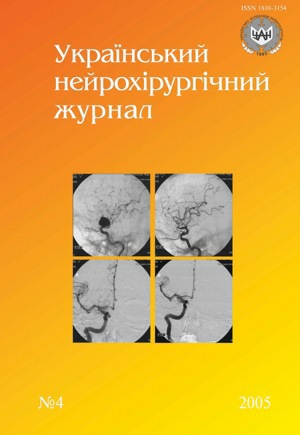The molecule-regulators contents after secondary brain injury investigation for prognosis of consequences at remote period
DOI:
https://doi.org/10.25305/unj.128598Keywords:
repeated head trauma, norepinephrine, epinephrine, dopamine, gamma-aminobutyric acidAbstract
Plasma norepinephrine, epinephrine, dopamine and gamma-aminobutiric acid (GABA) contents in patients blood with secondary brain injury were investigated. Norepinephrine and GABA contents decreasing and epinephrine and dopamine contents increasing were founded. Changes observed in neuromediators contents were founded at the end of hospitalization also. These results pointed to adaptive systems tension and creating of the conditions of a high risk for secondary pathological events development or exacerbation.
References
Бабиченко Е.И. Повторная закрытая черепно-мозговая травма // Журн. невропатологии и психиатрии им. С.С. Корсакова. — 1993. — Т.93, вып.2. — С.47–50.
Бабиченко Е.И., Хурина А.С. Повторная черепно-мозговая травма. — Саратов: Изд-во Сарат. ун-та, 1982. — 144 с.
Білоцерківська М.В. Особливості вищих психічних функцій у хворих з віддаленими наслідками повторної черепно-мозкової травми // Укр. вісн. психоневрол. — 1996. — Т.4, вип.5(12). — С.357–359.
Бонецкий А.А., Федоров В.И. Определение катехоламинов плазмы крови методом высокоэффективной жидкостной хроматографии на микроколоночном хроматографе “Милихром” // Лаб.дело. — 1989. — №4. — С.21–25.
Дунаєвський О.Є., Дунаєвська С.Г., Омельченко В.В. та ін. Вегетативні порушення у клінічному перебігу легкої повторної черепно-мозкової травми // Укр. вісн. психоневрол. — 1996. — Т.4, вип.3(10). — С.335–336.
Ковалев Г.В., Тюренков И.Н. ГАМК-ергическая система и регуляция кровообращения // Фармакология и токсикология. — 1986. — Т.49, №3. — C.11–22.
Кучеренко Н.Е., Германюк Я.Л., Васильев А.Н. Молекулярные механизмы гормональной регуляции обмена веществ. — К.: Вища шк., 1986. — 248 с.
Мишунина Т.М. Содержание гамма-аминомасляной кислоты и активность глутаматдекарбоксилазы в плазме крови здоровых людей // Вопр. мед. химии. — 1990. — T.36, №2. — C.22–34.
Пархомец В.П. Системы трансмембранного переноса нейромедиаторов в динамике экспериментального сотрясения мозга: Автореф. дис. ... канд. мед. наук. — К., 1990. — 17 с.
Петров В.И. Изучение действия гамма-аминомасляной кислоты на центральные и периферические симпатические механизмы // Фармакология и токсикология. — 1983. — T.46, №1. — C.13–16.
Хаулыке Е И. Вегетативная нервная система. Анатомия и физиология. — Бухарест, 1978. — 350 с.
Чопик Н.Г. Метаболиты плазмы крови в остром периоде легкой черепно-мозговой травмы: Атореф.дис. … канд. биол. наук. — К., 1995. — 21 с.
Chiolero R., Berger M. Endocrine response to brain injury // New Horizinse. — 1994. — V.2, N4. — P.432–442.
Eliasson K. Stress and catecholamines // Acta Med. Scand. — 1984. — V.215. — P.197–221.
Goldstein D.S. Plasma norepinephrine as an indicator of sympathetic neural activity in clinical cardiology // Amer. J. Cardiol. — 1981. — V.48, N6. — P.1147–1154.
Konrad K., Gauggel S., Schurek J. Catecholamine functioning in children with traumatic brain injuries and children with attention-deficit/hyperactivity disorder // Brain Res. Cogn. Brain Res. — 2003. — V.16, N3. — Р.425–433.
Lemke D.M. Riding out the storm: sympathetic storming after traumatic brain injury // J. Neurosci. Nurs. — 2004. — V.36, N1. — Р.4–9.
Lingren S., Andren N.E., Grabowska-Andren M. A fluorimetric method for determination of GABA in tissues following cation exchange chromatography and condensation with 7o 0-phthalaldehyde // J. Neural. Transmis. — 1982. — V.55. — P.243–252.
McAllister T.W., Flashman L.A., Sparling M.B., Saykin A.J. Working memory deficits after traumatic brain injury: catecholaminergic mechanisms and prospects for treatment — a review // Brain Inj. — 2004. — V.18, N4. — Р.331–350.
Mirzoian R.S. Neuroprotective and cerebrovascular effects of GABA mimetics // Eksp. Klin. Farmakol. — 2003. — V.66, N2. — Р.53–56.
Neugebauer E., Hensler T., Rose S. et al. Severe craniocerebral trauma in multiple trauma. An assessment of the interaction of local and systemic mediator responses // Unfallchirurg. — 2000. — Bd.103, H2. — S.122–131.
Patt S., Brodhun N. Neuropathological sequelae of traumatic injury in the brain. An overview. // Exp. Toxicol. Pathol. — 1999. — V.51, N2. — P.119–123.
Ruppel R.A., Clark R.S., Bayir H. et al. Critical mechanisms of secondary damage after inflicted head injury in infants and children // Neurosurg. Clin. N. Amer. — 2002. — V.13, N2. — Р.169–182.
Sahuquillo J., Poca M.A., Amoros S. Current aspects of pathophysiology and cell dysfunction after severe head injury // Curr. Pharm. Des. — 2001. — V.7, N15. — Р.1475–1503.
Vasilyeva I.G., Chopick N.G., Cherchenko A.P. Alteration of the neurotransmitter contents in the rabbit brain functional structures // Recent Advances in Neurotraumatology / Eds. N. Nakamura et al. — Tokyo: Springer – Verlag, 1993. — P.219–222.
Downloads
How to Cite
Issue
Section
License
Copyright (c) 2005 N. V. Kadzhaya, I. G. Vasilyeva, N. G. Chopick, O. I. Tsyubko

This work is licensed under a Creative Commons Attribution 4.0 International License.
Ukrainian Neurosurgical Journal abides by the CREATIVE COMMONS copyright rights and permissions for open access journals.
Authors, who are published in this Journal, agree to the following conditions:
1. The authors reserve the right to authorship of the work and pass the first publication right of this work to the Journal under the terms of Creative Commons Attribution License, which allows others to freely distribute the published research with the obligatory reference to the authors of the original work and the first publication of the work in this Journal.
2. The authors have the right to conclude separate supplement agreements that relate to non-exclusive work distribution in the form of which it has been published by the Journal (for example, to upload the work to the online storage of the Journal or publish it as part of a monograph), provided that the reference to the first publication of the work in this Journal is included.









